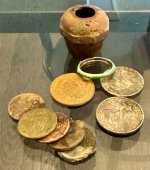FiresEye
Sr. Member
- Aug 17, 2010
- 322
- 5
Seems to me working with clay material in a recirculating sluice is a big failure at home because the water clays up and all the gold runs right off...
For the first time ever, I found gold in the very last riffle of my ove r20 riffle home-made sluice( yes over 20 riffles!)
Before now, all the gold I've found has been in the top 50% of the sluice.. but this way, there's gold on almost every riffle, even the last, and that means gold is running right off...
And no, the riffels aren't clogged either..
So it's true about the clay.
So it seems maybe the only way to really deal with clayey material without wasting tons of water from the hose would be to take a bucket of material to a stream and swirl it around letting the fresh water wash the clay out...
I don't mind wasting a little water here and there, but to wash a 5 gallong bucket of clay out with a hose in a bucket would probably take 100 gallons.
And, where I live, you get charged sewage for the water whether it's from the toilet or from the garden water hose
I might need to look into getting my water re-sectioned for different uses.. because the sewage bill is hefty.
Other than that, I guess I could have two 20 gallon buckets, and maybe let the clay settle to recirculate the clean water at the top, but after several minutes, the water is too cloudy again.
So, guess I'm gonna have to lug this 5 gallon bucket to the river with a big stick and get stirring...I think there may be a place I can do this at a local park( much closer than the source of this gold laden clay)...
Any ideas? etc?
Will keep you updated.
For the first time ever, I found gold in the very last riffle of my ove r20 riffle home-made sluice( yes over 20 riffles!)
Before now, all the gold I've found has been in the top 50% of the sluice.. but this way, there's gold on almost every riffle, even the last, and that means gold is running right off...
And no, the riffels aren't clogged either..
So it's true about the clay.
So it seems maybe the only way to really deal with clayey material without wasting tons of water from the hose would be to take a bucket of material to a stream and swirl it around letting the fresh water wash the clay out...
I don't mind wasting a little water here and there, but to wash a 5 gallong bucket of clay out with a hose in a bucket would probably take 100 gallons.
And, where I live, you get charged sewage for the water whether it's from the toilet or from the garden water hose

I might need to look into getting my water re-sectioned for different uses.. because the sewage bill is hefty.
Other than that, I guess I could have two 20 gallon buckets, and maybe let the clay settle to recirculate the clean water at the top, but after several minutes, the water is too cloudy again.
So, guess I'm gonna have to lug this 5 gallon bucket to the river with a big stick and get stirring...I think there may be a place I can do this at a local park( much closer than the source of this gold laden clay)...
Any ideas? etc?
Will keep you updated.
Amazon Forum Fav 👍
Upvote
0





